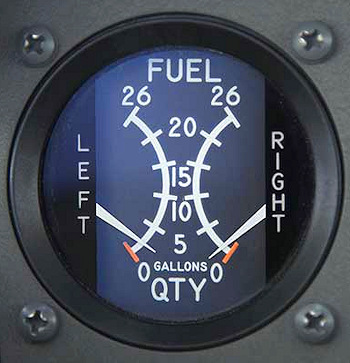Subscriber question:
"The fuel gauges in the airplane I rent are nearly useless. Often, they show empty even when there is gas in the tank. Or when they do seem to be working, they don't accurately reflect how much gas is in the tanks. I’ve been told that legally, fuel gauges only need to be accurate when the tanks are empty. Is that true?" - Greg M.
Ryan:
 “Common sense would suggest this isn’t true, and, in fact, it isn’t. FAR 91.205 says that a fuel gauge indicating the quantity of fuel in each tank is required equipment. If the tanks are half full, a gauge that reads empty is not doing its FAR 91.205 mandated job. So where did this idea come from?
“Common sense would suggest this isn’t true, and, in fact, it isn’t. FAR 91.205 says that a fuel gauge indicating the quantity of fuel in each tank is required equipment. If the tanks are half full, a gauge that reads empty is not doing its FAR 91.205 mandated job. So where did this idea come from?
The common misconception originates from the pre-2017 version of FAR 23 for aircraft certification. FAR 23.1337(b)(1) stated that each fuel quantity indicator must be calibrated to read ‘zero’ during level flight when the quantity of fuel remaining in the tank is equal to the unusable fuel supply. In other words, fuel gauges should be calibrated in terms of remaining usable fuel. But zero usable fuel isn’t the only time they’re required to be accurate. This immediately followed FAR 23.1337(b), which stated that there must be a means to indicate to the flightcrew members the quantity of usable fuel in each tank during flight. An indicator that’s only accurate when the tanks are empty doesn’t satisfy that requirement. In 2017, FAR 23 was rewritten, eliminating that wording. The new FAR 23.2430 says that fuel systems must provide the flightcrew with a means to determine the total usable fuel available.
Then there’s the common sense safety issue. You measured the amount of fuel on board before flight, calculated your fuel burn, and determined how long you could fly for, including the required fuel reserve. But what if you made a mistake in the measurement or the calculation? What if you forgot to secure a fuel cap and now you’re venting fuel? What if the engine is burning more fuel than usual? Even if you have a fuel totalizer, it could be miscalibrated or it could have an incorrect starting fuel amount. Without working fuel gauges you might not know it—until the tanks are empty. At that point, the fact that the needles point to zero will be little consolation.
Too many general aviation accidents result from fuel mismanagement. With anything this safety-critical, you should have multiple means of cross-checking. Don’t tolerate fuel gauges that don’t tell you how much fuel you have.“
Aside from checking the fuel gauges, what's your preferred method to confirm you have enough fuel for the flight?
